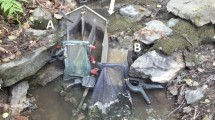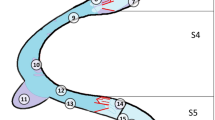Summary
The larval drift of the fire salamander was investigated over a period of three years in a mountain brook (Niederbergisches Land, F.R. Germany), as well in a laboratory water channel. The rate of larval drift fluctuated between 19% and 41% of the total population of larvae in a defined section of the brook during these three years. Most (83%) of the drifting larvae were hatchlings or very young stages. The drift was dependent on the strength of the current, the number of spawning females, the presence of suitable hiding places, sufficient space and adequate food. Hungry larvae drifted more often than satiated animals. The drift behaviour of hatchlings differed distinctly from that of older larvae. The significance of ecological factors on larval drift is discussed. It is evidently a more important factor in selection than has hitherto been recognized.
Similar content being viewed by others
References
Antonelli AL, Nussbaum RA, Smith SD (1972) Comparative food habits of four species of stream-dwelling vertebrates (Dicamptodon ensatus, D. copei, Cottus tenuis, Salmo gairdneri). Northwest Sci 46: 277–289
Bruce RC (1985) Larval periods, population structure and the effects of stream drift in larvae of the salamander Desmognathus quadramaculatus and Leurognathus marmoratus in a southern Appalachian stream. Copeia 1985: 847–854
Bruce RC (1986) Upstream and downstream movements of Eurycea bislineata and other salamanders in a southern Appalachian stream. Herpetologica 42: 149–155
Elliott JM (1976) The downstream drifting of eggs of brown trout, Salmo trutta L. J Fish Biol 9: 45–50
Elliott JM (1987) The distances travelled by downstream-moving trout fry, Salmo trutta, in a Lake District stream. Freshw Biol 17: 491–499
Johnson JE, Goldberg AS (1975) Movement of larval two lined salamanders (Eurycea bislineata) in the Mill river Massachusetts. Copeia 1975: 588–589
Joly J (1968) Données écologiques sur la salamandre tachetée Salamandra salamandra (L.). Ann Sci Nat Zool Ser 12 10: 301–366
Jusczcyk W, Zakrzewski M (1981) External morphology of larval stages of the spotted salamander, Salamandra salamandra (L.). Acta Biol Cracov 23: 127–135
Müller K (1954) Investigations on the organic drift in north Swedish streams. Rep Inst Fresh Res Drottningholm 35: 133–148
Müller K (1974) Stream drift as a chronobiological phenomenon in running water ecosystems. Ann Rev Ecol Syst 5: 309–323
Nussbaum RA (1985) The evolution of parental care in salamanders. Misc Pub Mus Zool Univ Michigan 169: 1–50
Petranka JW (1983) Fish predation: a factor affecting the spatial distribution of a stream-breading salamander. Copeia 1983: 624–628
Petranka JW, Sih A (1986) Environmental instability, competition, and density-dependent growth and survivorship of a streamdwelling salamander. Ecology 67: 729–736
Petranka JW, Sih A, Kats LB, Holomuzki JR (1987) Stream drift, size-specific predation, and the evolution of ovum size in an amphibian. Oecologia 71: 624–630
Schuhmacher H (1969) Kompensation der Abdrift von Köcherfliegen-Larven (Insecta, Trichoptera). Naturwissenschaften 56: 378
Semlitsch RD (1987) Interactions between fish and salamander larvae. Costs of predator avoidance or competition? Oecologia 72: 481–486
Stangel PW, Semlitsch RD (1987) Experimental analysis of predation on the diel vertical migrations of a larval salamander. Can J Zool 65: 1554–1558
Stoneburner DL (1978) Salamander drift: observations on the two-lined salamander (Eurycea bislineata). Freshw Biol 8: 291–293
Thiesmeier B (1987) Observations on stream drift in larvae of Salamandra salamandra terrestris Lacépède, 1788. Proc Fourth Ord Gen Meet S.E.H. Nijmegen 1987: 403–406
Waters TF (1972) The drift of stream insects. Ann Rev Entomol 17: 253–272
Author information
Authors and Affiliations
Rights and permissions
About this article
Cite this article
Thiesmeier, B., Schuhmacher, H. Causes of larval drift of the fire salamander, Salamandra salamandra terrestris, and its effects on population dynamics. Oecologia 82, 259–263 (1990). https://doi.org/10.1007/BF00323543
Received:
Revised:
Accepted:
Issue Date:
DOI: https://doi.org/10.1007/BF00323543




